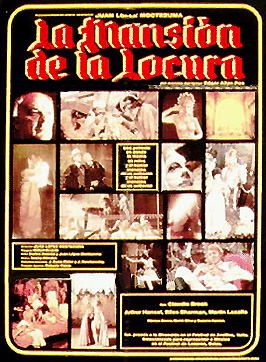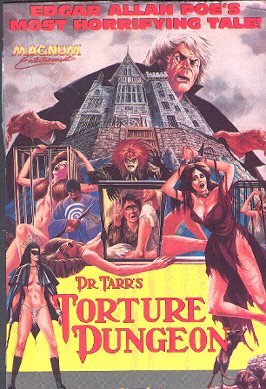
(Prods. Prisma**, 1971) Prod: Roberto Biskin; Dir: Juan López Moctezuma; Scr: Carlos Illescas, Juan López Moctezuma; Addtl text: Gabriel Weiss; Orig Story: Edgar Allan Poe ("The System of Dr. Tarr and Professor Feather"); Photo: Rafael Corkidi; Music: Nacho Méndez; Assoc Prod: José Borchowsky, Jacobo Guss Elster; Prod Mgr: Luis Bekris; Asst Dir: Tito Novaro; Film Ed: Federico Landeros; Costume Supv: Leonora Carrington; Art Realization: Gabriel Weiss; Choreog: Tita Arroyo; Camera Asst: Miguel Garzón; Makeup: Graciela González; Dialog Rec: Ricardo Saldívar
**The print used for the Magnum Video version carries a 1975 copyright date for "V.I.P. Productions."
CAST: Claudio Brook ("Dr. Maillard" aka Raúl Fragonard), Arthur Hansel (Gastón Leblanc), Ellen Sherman (Eugenie), Martín Lasalle (Julién Couvier), David Silva (priest), Mónica Serna (Julién's niece), Max Kerlow (real Dr. Maillard), Susana Kamini (priestess), Francisco Córdoba ("Marshal"), Roberto Dumont, Henry West, Jorge Bekris (Henri), René Alis, Mario Castillón Bracho, Oscar Saro, Diane Shay [?Sharp], Virgilio Leos, Abraham Stabans, Paloma Zozaya, Sofía Solorio, Julia Marichal, Ramón Barragán, José Antonio Alcaraz, Nadine Markova, Javier Bátiz Macaria, Peter Jones, Victorio Blanco (old monk), Gerardo Zepeda (bandit), René Barrera (bandit), Juan Garza (bandit), Kevin McCormick, León Singer, Vicente Lara (bandit), Antonio Zubiaga (soldier), Joan Mary, Simon Alikan, Sammy Viskin, Lya Engel, María Antonieta Domínguez, Beatriz Velo
NOTES: This is not a great film, but it is a very good one, the first
directorial effort by Juan López Moctezuma, who had been associated
with Alejandro Jodorowsky on that director's earlier pictures. The
English-language version (at least the one released on videotape) is
significantly shorter (82 minutes) than the (reported) length of the
original (99 minutes, according to the Filmoteca Nacional database), but
there are no glaring plot holes (although in fact, the plot isn't that
complex to begin with). 
Mostly shot on location (including an abandoned textile mill), La mansión de la locura is a wonderful visual experience, filled with baroque images, although some scenes show a tendency towards theatrical staging. The sequences inside the mansion are also acted in a theatrical manner, with long, flamboyant discourses (the scenes in the woods outside the walls of the asylum are more naturalistic in tone).
But, despite the fact that this was López Moctezuma's first feature film as a director (he had worked primarily in radio and the theatre), La mansión de la locura is generally not slow or stagey. The camerawork and editing are quite fluid, stylish and professional (there is an exciting fight between Gastón, Julién and some bandits, for instance).
La mansión... is also deliberately humorous, almost absurdist in tone, in some ways (even visually) reminiscent of (except that it actually pre-dates) Monty Python and the Holy Grail. Julién Couvier is the butt of some of this humor: captured by "bandits" from the asylum, he is bound and gagged but escapes by hopping away (with "funny" music on the soundtrack) when his captors are distracted. Another sequence features "Mr. Chicken," a feathered mental patient (who brings to mind the old joke with the punchline: "But we needed the eggs!"). It's hard to imagine the reaction to these aspects by a U.S. audience lured in to see something called Dr. Tarr's Torture Dungeon, and expecting a routine horror movie!
The film also contains a variety of literary (and filmic) allusions. These include Aleister Crowley ("Do as thou wilt shall be the whole of the law"), John Donne (the "I run to death" quote, also heard in Val Lewton's The Seventh Victim), the "Rime of the Ancient Mariner," and even Little Caesar (as the false doctor expires, he says "Can this be the end of Maillard?").
La mansión de la locura (or to be more exact, Dr. Tarr's Torture Dungeon, which is the version I have seen) begins and ends with voiceover narration by Gastón Leblanc; presumably this is from Edgar Allan Poe's original story. The time is the late 1800s: Gastón was born in France but educated as a journalist in the United States; he is back in his native land to write a story about the mental hospital run by Dr. Maillard, who reportedly uses novel methods. Gastón is sharing a coach with his friend Julién--whose estate is near the asylum--and Julién's niece. Their coachman is the immensely strong Henri. The occupants of the coach are surprised to see an aged monk confronting an odd man (his top hat sports several branches, like antlers) on the forest roadway. At the gate of the asylum, Gastón is originally denied entry by several armed guards, but he is eventually admitted, and bids Julién goodbye. However, a short distance away, the coach is attacked by "bandits" (inmates from the asylum), who rape Julién's niece and tie them all up. As noted above Julién later manages to make his escape.
Meanwhile, Gastón has met the flamboyant Dr. Maillard and his beautiful daughter Eugenie. Maillard says the patients at the asylum--most of whom are wandering around freely--are encouraged to explore their fantasies and delusions as a path towards recovery. For some, like "Dante" who is locked up in a dungeon, the treatment is less generous. Gastón also notes that not all of the patients are well-disposed towards the doctor: at end of a performance of a dance, Eugenie even tries to stab Maillard!
That night, Eugenie and Gastón meet. She tells him that "Dr.
Maillard" is really a notorious bandit named Raúl Fragonard, who
escaped from Devil's Island and came to her father's asylum to hide out.
He then fomented a revolt among the patients, and now runs the institution
as his private kingdom. Eugenie and Gastón escape into the forest,
pursued by Fragonard's men. They join forces with Julién, but
eventually are all recaptured. Julién is thrown into a cell with
the real Dr. Maillard and Henri the coachman.

At a grand ceremony, Fragonard condemns Eugenie and Gastón to death. Three "crow men" appear and do a long, intricate dance of death (these performers--obviously professional dancers--are made up to look like members of Kiss or even the much-later comic book character "The Crow"). But before they can use their razor-sharp scythes on the captives, Julién and the others arrive, having broken out of their cell. A battle ensues, and Fragonard is mortally wounded. Dr. Maillard regains control of his asylum.
Claudio Brook is satisfactory as Maillard/Fragonard, although by this time he was somewhat typecast as a fanatic (Arturo Ripstein would continue this trend by using him in El castillo de la pureza the following year); he worked again for López Moctezuma in Alucarda. Arthur Hansel, usually a professional gringo in Mexican movies, has the hero's role, a rarity for him (López Moctezuma would also give him a major role in Mary, Mary, Bloody Mary); Ellen Sherman was not a Mexican cinema regular, although she had been in some Hollywood productions, and acquits herself adequately. The rest of the cast includes some performers who would become López Moctezuma regulars: Susana Kamini, Martín Lasalle, and David Silva (who had appeared in El Topo as the bandit leader).
Final notes: the Magnum video of this film has the main title in English, but the opening credits are in Spanish. Then the end credits are in English! The typeface is the same for all. Some of the minor characters seem to have been dubbed into English, but most of the major performers seem to be doing their own dialogue. Regarding this and López Moctezuma's other films, I am not sure if the Mexican release versions were entirely dubbed into Spanish (i.e., even those performers who were bilingual and could have done their own Spanish dialogue), or if Claudio Brook, et al, did their own dubbing. Given the budgetary circumstances under which López Moctezuma worked, I seriously doubt if he shot two versions of scenes--one in English, one in Spanish--so that the ironic circumstance is that these "Mexican" movies were probably made (mostly) in English! (note: unlike many Italian and Spanish movies, Mexican films were generally shot with "live" sound, rather than being shot silent and entirely post-dubbed)
Certainly a highly recommended film.